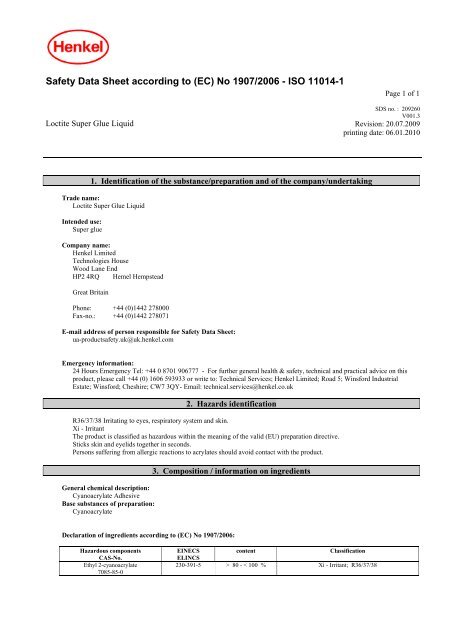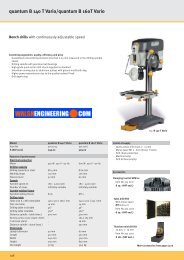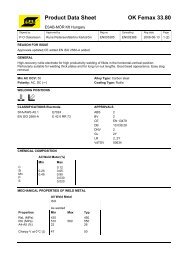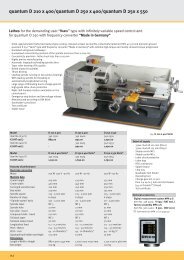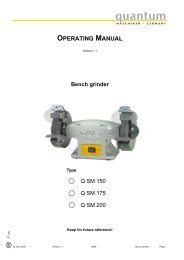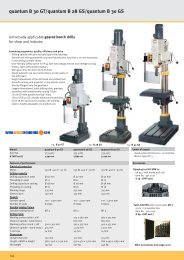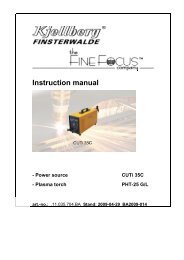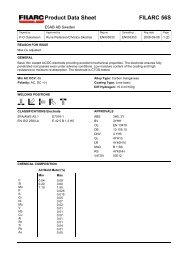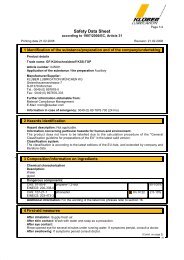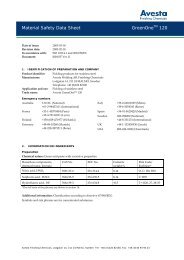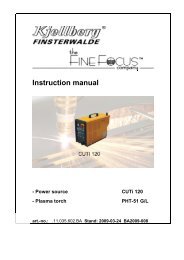Loctite Super Glue Liquid.pdf - Walsh Engineering
Loctite Super Glue Liquid.pdf - Walsh Engineering
Loctite Super Glue Liquid.pdf - Walsh Engineering
Create successful ePaper yourself
Turn your PDF publications into a flip-book with our unique Google optimized e-Paper software.
Safety Data Sheet according to (EC) No 1907/2006 - ISO 11014-1Page 1 of 1<strong>Loctite</strong> <strong>Super</strong> <strong>Glue</strong> <strong>Liquid</strong>SDS no. : 209260V001.3Revision: 20.07.2009printing date: 06.01.20101. Identification of the substance/preparation and of the company/undertakingTrade name:<strong>Loctite</strong> <strong>Super</strong> <strong>Glue</strong> <strong>Liquid</strong>Intended use:<strong>Super</strong> glueCompany name:Henkel LimitedTechnologies HouseWood Lane EndHP2 4RQ Hemel HempsteadGreat BritainPhone: +44 (0)1442 278000Fax-no.: +44 (0)1442 278071E-mail address of person responsible for Safety Data Sheet:ua-productsafety.uk@uk.henkel.comEmergency information:24 Hours Emergency Tel: +44 0 8701 906777 - For further general health & safety, technical and practical advice on thisproduct, please call +44 (0) 1606 593933 or write to: Technical Services; Henkel Limited; Road 5; Winsford IndustrialEstate; Winsford; Cheshire; CW7 3QY- Email: technical.services@henkel.co.uk2. Hazards identificationR36/37/38 Irritating to eyes, respiratory system and skin.Xi - IrritantThe product is classified as hazardous within the meaning of the valid (EU) preparation directive.Sticks skin and eyelids together in seconds.Persons suffering from allergic reactions to acrylates should avoid contact with the product.General chemical description:Cyanoacrylate AdhesiveBase substances of preparation:Cyanoacrylate3. Composition / information on ingredientsDeclaration of ingredients according to (EC) No 1907/2006:Hazardous componentsCAS-No.Ethyl 2-cyanoacrylate7085-85-0EINECScontentClassificationELINCS230-391-5 > 80 - < 100 % Xi - Irritant; R36/37/38
MSDS-No.: 209260V001.3<strong>Loctite</strong> <strong>Super</strong> <strong>Glue</strong> <strong>Liquid</strong> Page 2 of 2For full text of the R-Phrases indicated by codes see section 16 'Other Information'.Substances without classification may have community workplace exposure limits available.Inhalation:Move to fresh air, consult doctor if complaint persists.4. First aid measuresSkin contact:Do not pull bonded skin apart. It may be gently peeled apart using a blunt object such as a spoon, preferably after soaking inwarm soapy water.Cyanoacrylates give off heat on solidification. In rare cases a large drop will generate enough heat to cause a burn.Burns should be treated normally after the adhesive has been removed from the skin.If lips are accidentally stuck together apply warm water to the lips and encourage maximum wetting and pressure from salivainside the mouth.Peel or roll lips apart. Do not try to pull the lips apart with direct opposing action.Eye contact:If the eye is bonded closed, release eyelashes with warm water by covering with wet pad.Cyanoacrylate will bond to eye protein and will cause periods of weeping which will help to debond the adhesive.Keep eye covered until debonding is complete, usually within 1-3 days.Do not force eye open. Medical advice should be sought in case solid particles of cyanoacrylate trapped behind the eyelidcause any abrasive damage.Ingestion:Ensure that breathing passages are not obstructed. The product will polymerise immediately in the mouth making it almostimpossible to swallow. Saliva will slowly separate the solidified product from the mouth (several hours).Suitable extinguishing media:foam, extinguishing powder, carbon dioxide.fine water spray5. Fire fighting measuresExtinguishing media which must not be used for safety reasons:High pressure waterjetSpecial protection equipment for firefighters:Fire fighters should wear positive pressure self-contained breathing apparatus (SCBA).Wear protective equipment.Hazardous combustion products:Oxides of carbon, oxides of nitrogen, irritating organic vapors.Personal precautions:Ensure adequate ventilation.6. Accidental release measuresEnvironmental precautions:Do not let product enter drains.Do not allow to enter in surface / ground water.
MSDS-No.: 209260V001.3<strong>Loctite</strong> <strong>Super</strong> <strong>Glue</strong> <strong>Liquid</strong> Page 3 of 3Clean-up methods:Do not use cloths for mopping up. Flood with water to complete polymerization and scrape off the floor. Cured material canbe disposed of as non-hazardous waste.Dispose of contaminated material as waste according to item 13.7. Handling and storageHandling:Ventilation (low level) is recommended when using large volumesUse of dispensing equipment is recommended to minimise the risk of skin or eye contactOpen and handle container with care.Storage:For optimum shelf life store in original containers under refrigerated conditions at 2 - 8°C (35.6 - 46.4 °F)Store in a cool place, max. storage temperature 30°C.Store in a dry place.Keep container tightly sealed and store in a frost free place.Do not store together with food or other consumables (coffee, tea, tobacco, etc.).8. Exposure controls / personal protectionComponents with specific control parameters for workplace:Valid forGreat BritainBasisUK EH40 WELsIngredient ppm mg/m 3 Type Category RemarksETHYL CYANOACRYLATE0,3 1,5 Short Term ExposureEH40 WEL7085-85-0Limit (STEL):<strong>Engineering</strong> controls:Draw off vapors and fumes directly at the point of generation or release. In the case of regular work use bench-mountedextraction equipment.Hand protection:For shorttime contact (e.g. as protection against splashes) protective gloves made from nitrile rubber are recommendedaccording to EN 374.material thickness > 0.4 mmPerforation time > 480 minutesIn the case of longer and repeated contact please note that in practice the penetration times may be considerably shorter thanthose determined according to EN 374. The protective gloves must always be checked for their suitability for use at thespecific workplace (e.g. mechanical and thermal stress, product compatibility, antistatic effects, etc.). The gloves must bereplaced immediately at the first signs of wear and tear. The information provided by the manufacturers and given in therelevant trade association regulations for industrial safety must always be observed. We recommend that a hand care plan isdrawn up in cooperation with a glove manufacturer and the trade association in accordance with the local operatingconditions.When processing large amounts.Eye protection:Goggles which can be tightly sealed.General protection and hygiene measures:Avoid skin and eye contact.Do not eat, drink or smoke while working.Good industrial hygiene practices should be observed.
MSDS-No.: 209260V001.3<strong>Loctite</strong> <strong>Super</strong> <strong>Glue</strong> <strong>Liquid</strong> Page 4 of 49. Physical and chemical propertiesGeneral characteristics:AppearanceOdor:<strong>Liquid</strong>colourlessirritatingPhys./chem. properties:Boiling pointFlash pointVapor pressure(25 °C (77 °F))Density()Solubility (qualitative)(Solvent: Water)> 100 °C (> 212 °F)80 - 93,4 °C (176 - 200.12 °F)< 0,5 mbar1,05 g/cm3Polymerises in presence of water.Conditions to avoid:Stable under normal conditions of storage and use.10. Stability and reactivityMaterials to avoid:Rapid exothermic polymerization will occur in the presence of water, amines, alkalis and alcohols.Hazardous decomposition products:None known11. Toxicological informationGeneral toxicological information:To the best of our knowledge no harmful effects are to be expected if the product is handled and used properly.Oral toxicity:Cyanoacrylates are considered to have relatively low toxicity. Acute oral LD50 is >5000mg/kg (rat). It is almost impossibleto swallow as it rapidly polymerises in the mouth.Inhalative toxicity:Irritating to respiratory systemProlonged exposure to high concentrations of vapours may lead to chronic effects in sensitive individualsIn dry atmosphere with < 50% humidity, vapours may irritate the eyes and respiratory systemSkin irritation:Irritating to the skin.Bonds skin in seconds. Considered to be of low toxicity: acute dermal LD50 (rabbit)>2000mg/kgDue to polymerisation at the skin surface allergic reaction is unlikely to occurEye irritation:Irritating to eyes.<strong>Liquid</strong> product will bond eyelids. In a dry atmosphere (RH
MSDS-No.: 209260V001.3<strong>Loctite</strong> <strong>Super</strong> <strong>Glue</strong> <strong>Liquid</strong> Page 5 of 5Persistence and degradability:Ultimate biodegradation:The total of the organic components contained in the product achieve values below 60% BOD/COD or CO2 liberation, orbelow 70% DOC reduction in tests for ease of degradability. Threshold values for 'readily degradable' (e.g. to OECD method301) are not reached.The product contains polymere components that are degradable to a large extent.General ecological information:Biological and Chemical Oxygen Demands (BOD and COD) are insignificant.Do not empty into drains / surface water / ground water.13. Disposal considerationsProduct disposal:Cured adhesive: Dispose of as water insoluble non-toxic solid chemical in authorised landfill or incinerate under controlledconditions.Dispose of in accordance with local and national regulations.The valid EEC waste code numbers are not product-related but are largely source-related. The manufacturer is thereforeunable to specify EEC waste codes for the articles or products used in the various sectors. These can be requested from themanufacturer.Disposal of uncleaned packages:After use, tubes, cartons and bottles containing residual product should be disposed of as chemically contaminated waste inan authorised legal land fill site or incinerated.Disposal must be made according to official regulations.Road transport ADR:Not dangerous goodsRailroad transport RID:Not dangerous goodsInland water transport ADN:Not dangerous goodsMarine transport IMDG:Not dangerous goodsAir transport IATA:14. Transport informationClass: 9Packaging group:Packaging instructions (passenger) 906Packaging instructions (cargo) 906UN no.: 3334Label: 9Proper shipping name:Aviation regulated liquid, n.o.s. (Cyanoacrylate ester)
MSDS-No.: 209260V001.3<strong>Loctite</strong> <strong>Super</strong> <strong>Glue</strong> <strong>Liquid</strong> Page 6 of 615. Regulations - classification and identificationXi - IrritantIndication of danger:Risk phrases:R36/37/38 Irritating to eyes, respiratory system and skin.Safety phrases:S2 Keep out of the reach of children.S23 Do not breathe vapour.S24/25 Avoid contact with skin and eyes.S26 In case of contact with eyes, rinse immediately with plenty of water and seek medical advice.Additional labeling:Cyanoacrylate. Danger. Bonds skin and eyes in seconds. Keep out of the reach of children.16. Other informationThe labelling of the product is indicated in Section 15. The full text of the R-phrases indicted by codes in this safety data sheetare as follows:R36/37/38 Irritating to eyes, respiratory system and skin.Further information:This information is based on our current level of knowledge and relates to the product in the state in which it is delivered. It isintended to describe our products from the point of view of safety requirements and is not intended to guarantee anyparticular properties.


